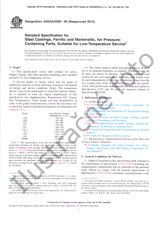Potrebujeme váš súhlas na využitie jednotlivých dát, aby sa vám okrem iného mohli ukazovať informácie týkajúce sa vašich záujmov. Súhlas udelíte kliknutím na tlačidlo „OK“.
ASTM D1726-11(2019)
Standard Test Methods for Hydrolyzable Chloride Content of Liquid Epoxy Resins
NORMA vydaná dňa 1.6.2019
Informácie o norme:
Označenie normy: ASTM D1726-11(2019)
Dátum vydania normy: 1.6.2019
Kód tovaru: NS-951295
Počet strán: 4
Približná hmotnosť: 12 g (0.03 libier)
Krajina: Americká technická norma
Kategória: Technické normy ASTM
Kategórie - podobné normy:
Anotácia textu normy ASTM D1726-11(2019) :
Keywords:
hydrolyzable chloride, liquid epoxy resin, saponifiable chloride ,, ICS Number Code 83.080.10 (Thermosetting materials)
Doplňujúce informácie
| Significance and Use | ||||||||||||
|
5.1 The hydrolyzable chloride content of liquid epoxy resins is an important variable in determining their reactivity and the properties of coatings made from them. These test methods may be used to determine the hydrolyzable chloride content of manufactured epoxy resins and confirm the stated hydrolyzable chloride content of purchased epoxy resins. |
||||||||||||
| 1. Scope | ||||||||||||
|
1.1 These test methods cover the determination of the easily hydrolyzable chloride content of liquid epoxy resins which are defined as the reaction product of a chlorohydrin and a di- or polyfunctional phenolic compound. Note 1: There is no known ISO equivalent to this
standard.
1.1.1 In Test Method A, the easily hydrolyzable chloride is saponified with potassium hydroxide and directly titrated with hydrochloric acid. This test method can be used for concentrations of 1 weight % and below. 1.1.2 In Test Method B, the easily hydrolyzable chloride is again saponified with potassium hydroxide, then titrated potentiometrically with silver nitrate. This test method can be used for concentrations of 5 to 2500 ppm hydrolyzable chloride. 1.2 The values stated in SI units are to be regarded as the standard. The values given in parentheses are for information only. 1.3 This standard does not purport to address all of the safety concerns, if any, associated with its use. It is the responsibility of the user of this standard to establish appropriate safety, health, and environmental practices and determine the applicability of regulatory limitations prior to use. 1.4 This international standard was developed in accordance with internationally recognized principles on standardization established in the Decision on Principles for the Development of International Standards, Guides and Recommendations issued by the World Trade Organization Technical Barriers to Trade (TBT) Committee. |
||||||||||||
| 2. Referenced Documents | ||||||||||||
|




 Cookies
Cookies
